| |
 |
| |
Temporary
Monuments
Lize Mogel
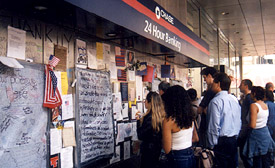
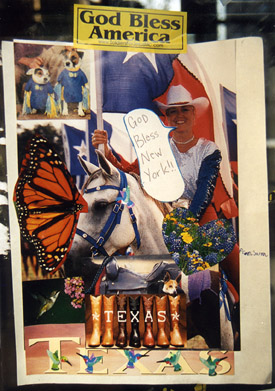 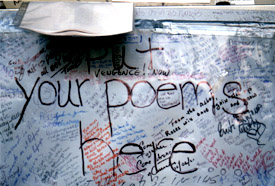 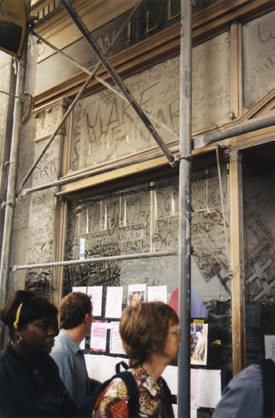 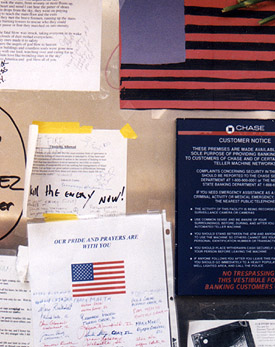 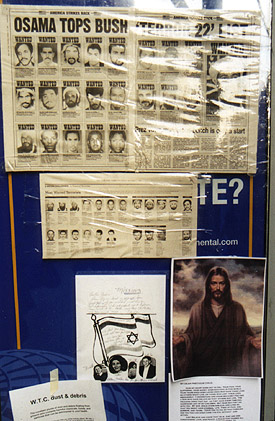 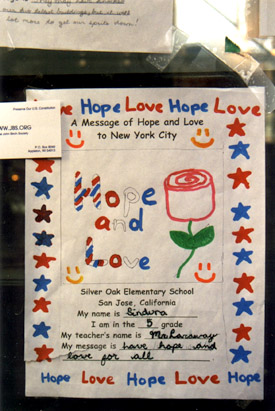 |
|
The fall of the World Trade Center in September was immediately
followed by a media-driven discussion about a memorial,
or a material gesture of remembrance. Certain of the media
looked to artists, architects and other "experts"
in the production of meaning to interpret the massive
loss and conflicting emotions experienced during the aftermath
of the event. The New York Times, bellwether for
the opinions of a portion of NY society, ran articles
asking certain cultural producers what they thought should
replace the physical and psychological hole left in lower
Manhattan. Several artists proposed parks; Richard Serra,
in keeping with his monumental body of work, called for
new buildings, even larger than the previous ones.
Within the art world itself, artists like many other citizens
met in groups informally and also within the confines
of institutions (museums, galleries, art schools). Galleries
and museums mounted exhibitions of work responding to
the events of 9/11; the New Museum hosted an exhibition
of artists from the Lower Manhattan Cultural Council Residency
Program which had been housed on the upper floors of Tower
1. One piece out of all the tributary work effectively
spoke of the demise of modernism and economic stability
symbolized by the WTC; Mahmoud Hamadani's recreation of
a 1970's Sol Lewitt modular cube structure, now crumbled
and fallen.
Many artists’ responses did not always enter a broader
public discourse. Instead, a new public art formed on
the street, with the vast accumulation of posters, objects,
and displays created and placed by a portion of the city’s
population; including residents, workers, tourists, and
passers-by. The public itself. This archive is, in its
totality, an inclusive, participatory artwork, which dwarfs
any deliberate gesture made by artists or institutions
to interpret the events and aftermath of 9/11.
Immediately after the WTC fell, missing posters went up
all over lower Manhattan. These were functionally futile
but had great value as a larger phenomenon; a temporal
memorial to the dead, an archive of souls. The posters
were eventually taken down (although an occasional new
one appeared on downtown lampposts) and replaced by handmade
signs, photographs, t-shirts, candles, stuffed animals,
flowers (real and fake), flags, banners. These collections
or shrines were at first distributed within any significant
gathering place below 14th Street. They are
now contained in fewer areas; a church fence near Ground
Zero; the subway station at Union Square; Grand Central
Station. All critical points of convergence and divergence,
and of maximum pedestrian traffic.
Most of the offerings near Ground Zero seem to be from
elsewhere- after all, it is a tourist site. There is a
visible effort to belong through mark-making, regardless
of the origins of the mark-maker. In the graffiti covering
the Paris cemetery where Jim Morrison is buried, the iconic
word "Jim" is carved into trees and sarcophagi, transcending
a need for translation. The repetition adds to Morrison's
mythos, whether inscribed in true mourning, idolatry,
or trendy grave-scribbling. These gestures are doubly
for the absent subject and for the author herself.
The singularity of the cemetery graffiti suggests an overarching
presence, despite subtleties of penmanship. The collection
of objects commemorating the WTC represents a more complex
authorship, stylistically and functionally diverse. Can
personal marks be writ large and monumentalized- or does
the monumentalization and reproduction of this type of
gesture remain purely sentimental, cliche, or kitschy?
This stands in opposition to traditional notions of monumentality;
size, mass, centrality, and permanence.
The New York Times championed the idea of Luxor-style,
twin searchlights shining upwards, filling the absence
left by the World Trade Towers with a brilliant ghost.
The intangibility of light is appropriate here, but the
purity of this abstract gesture is reductive. It speaks
more of the loss of architectural space than of bodies.
The physicality of the WTC is absent (wallboard, hallways,
cubicles, sweat and smell of human habitation), perhaps
better symbolized by the unruly shrines left as offerings
rather than the grand narratives of hope, goodness and
redemption symbolized by the columns of light. These collections,
or temporary monuments, to the WTC present a new paradigm
that cannot be easily contained within an institutional
frame.
There is an absence within this public artwork: that of
dissent. The mutable arrangement of objects exists within
social space that is legislated as such, by unspoken rules
of conduct that rooted and temporary communities perform
daily. During the first week after the attacks, an abundance
of hand-lettered signs appeared, expressing political
viewpoints and annotated by anonymous others. A month
later, with free speech rights vastly curtailed, all evidence
of true public discourse was removed in favor of sympathetic
and patriotic statements. Is this unity or a civic editorial
process? It remains to be seen if any future memorializing
gesture can reflect the true range of viewpoints. The
enormous absence of the WTC towers suggests an enormous
presence, which can be replaced by another monolith or
by a deliberate massing of the polysemic and the personal. | | |
 |
home | bios
| about |
contact
| links

©
2002, The Journal of Aesthetics and Protest
|
|

